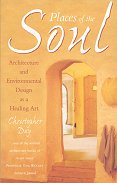Day wants to put the soul back into buildings. Buildings are for people to live and work in, and their design and placing should enhance that human experience.
The shapes and materials they are made of can have a profound effect on the people using them, and looking at them.
Yet most modern buildings and developments are soulless, which has a destructive effect on the human spirit. In particular, the more modern building materials can be subtly destructive of the aesthetic sense.
Also, modern construction techniques make it hard for a building to be a growing, developing artefact.
Day argues that it doesn't have to be this way.
He points out that the modern emphasis is on regularity, repetition, and efficiency, but with the wrong measures of efficiency.
Also, he points out that every site is different, and that designs suitable for one location are not suitable for all.
He calls for more feeling for aesthetics in the design process. Going with this feeling could potentially make every door and every window different, because they are each in a different place in the building, with a different view or opening on the exterior.
This can all get a bit Newage-y at times -- Day appears to believe in homeopathy, dowsing, and the razor-sharpening properties of pyramids. But he does not have that extreme "back to nature", human-hating, approach. Rather, he believes people, and their buildings, can enhance the environment.
Day provides a few specific guidelines -- from how to suggest a curve with a few straight lines to how to arrange a building contract that allows for changing designs and for the builders to be involved -- yet this work is mostly a plea for a return to aesthetics. There are many commonalities between the things that Day and Alexander identify as adding soul -- for example, Day mentions "light from two sides", Alexander codifies it as a pattern. In some sense this can be read as a preface to Alexander's work -- Day provides a better feel for what he means by "soul" (Alexander calls it the "quality without a name"), but Alexander goes further by identifying a large catalogue of practical design patterns that might be used to bring about such soul-ful building.
